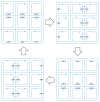An Efficient Distributed Area Division Method for Cooperative Monitoring Applications with Multiple UAVs
- PMID: 32570861
- PMCID: PMC7349070
- DOI: 10.3390/s20123448
An Efficient Distributed Area Division Method for Cooperative Monitoring Applications with Multiple UAVs
Abstract
This article addresses the area division problem in a distributed manner providing a solution for cooperative monitoring missions with multiple UAVs. Starting from a sub-optimal area division, a distributed online algorithm is presented to accelerate the convergence of the system to the optimal solution, following a frequency-based approach. Based on the "coordination variables" concept and on a strict neighborhood relation to share information (left, right, above and below neighbors), this technique defines a distributed division protocol to determine coherently the size and shape of the sub-area assigned to each UAV. Theoretically, the convergence time of the proposed solution depends linearly on the number of UAVs. Validation results, comparing the proposed approach with other distributed techniques, are provided to evaluate and analyze its performance following a convergence time criterion.
Keywords: area division; coordination variables; distributed system; frequency-based approach; monitoring; multi-UAV; unmanned aerial vehicles.
Conflict of interest statement
The authors declare no conflict of interest. The founding sponsors had no role in the design of the study; in the collection, analyses or interpretation of data; in the writing of the manuscript; nor in the decision to publish the results.
Figures












References
-
- Gupta L., Jain R., Vaszkun G. Survey of Important Issues in UAV Communication Networks. IEEE Commun. Surv. Tutor. 2016;18:1123–1152. doi: 10.1109/COMST.2015.2495297. - DOI
-
- Huang H., Savkin A.V. An Algorithm of Reactive Collision Free 3-D Deployment of Networked Unmanned Aerial Vehicles for Surveillance and Monitoring. IEEE Trans. Ind. Inform. 2020;16:132–140. doi: 10.1109/TII.2019.2913683. - DOI
-
- Yang Q., Yoo S. Optimal UAV Path Planning: Sensing Data Acquisition Over IoT Sensor Networks Using Multi-Objective Bio-Inspired Algorithms. IEEE Access. 2018;6:13671–13684. doi: 10.1109/ACCESS.2018.2812896. - DOI
-
- Scherer J., Yahyanejad S., Hayat S., Yanmaz E., Andre T., Khan A., Vukadinovic V., Bettstetter C., Hellwagner H., Rinner B. An autonomous multi-UAV system for search and rescue; Proceedings of the First Workshop on Micro Aerial Vehicle Networks, Systems, and Applications for Civilian Use; Florence, Italy. 18 May 2015; pp. 33–38.
LinkOut - more resources
Full Text Sources

